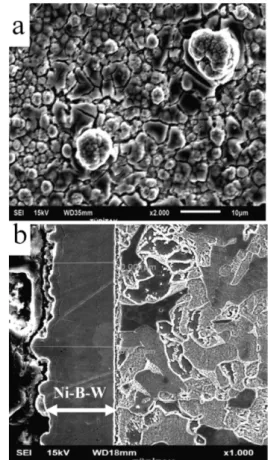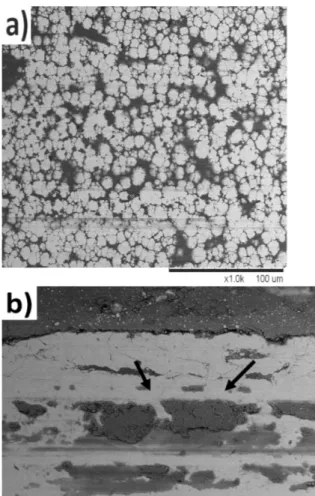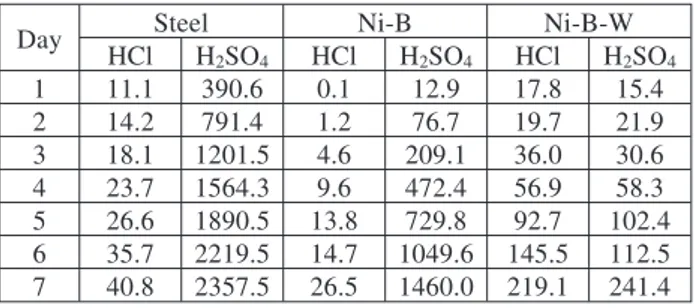A. I. AYDENIZ et al.: ELECTROLESS Ni-B-W COATINGS FOR IMPROVING HARDNESS, WEAR ...
ELECTROLESS Ni-B-W COATINGS FOR IMPROVING
HARDNESS, WEAR AND CORROSION RESISTANCE
NANA[ANJE Ni-B-W S CEMENTACIJSKIM GALVANIZIRANJEM
ZA IZBOLJ[ANJE TRDOTE, OBRABE IN ODPORNOSTI PROTI
KOROZIJI
Ali Imre Aydeniz1, Ali Göksenli1, Gökce Dil1, Faiz Muhaffel2, Cagdas Calli2,
Behiye Yüksel3
1TU Istanbul, Mechanical Engineering Department, 34437 Istanbul, Turkey
2TU Istanbul, Mechanical Metallurgical and Materials Eng. Dep., 34469 Maslak, Istanbul, Turkey 3Istanbul Aydin University, Dep. of Mechanical Engineering, 34668 Istanbul, Turkey
aydenizal@itu.edu.tr
Prejem rokopisa – received: 2013-03-26; sprejem za objavo – accepted for publication: 2013-04-08
In this study the formation of a Ni-B-W coating on steel using an electroless plating process and evaluation of the hardness, wear and corrosion resistance was analyzed. The Ni-B-W coating was prepared using an alkaline borohydride-reduced electro-less nickel bath. Scanning electron microscopy (SEM) of the cross-sectional view of the Ni-B-W coating was analyzed and the layer characteristics were investigated. The Ni-B-W coating was characterized using XRD. The study reveals that the Ni-B-W coating is amorphous in the as-plated condition and after heat treatment at 450 °C for 1 h the Ni-B-W coatings crystallize and produce nickel and nickel borides. The hardness of the as-plated and heat-treated Ni-B-W coatings were compared with Ni-B coatings. In both coatings the hardness increased with heat treatment. The wear resistance of Ni-B-W coatings annealed at different temperatures was analyzed using a ball-on-flat test. The wear resistance of the coating increased with heat treatment and reached a maximum value at 400 °C. An optical microscope and EDS analysis were applied on the wear tracks to determine the wear mechanism. Ductile failure and an abrasive wear mechanism were dominant for the coating heat treated up to 400 °C. Network cracks and shearing marks were detected for the coatings annealed at 450 °C and above, indicating brittle failure. For investigating the corrosion characteristics of the coatings, immersion tests in 5 % H2SO4and 10 % HCl acidic solutions for
seven days were applied. According to the corrosion test results, the Ni-B-W coatings showed good corrosion resistance in the H2SO4solutions.
Keywords: electroless plating, hardness, wear resistance, corrosion resistance, Ni-B-W coating
V tej {tudiji je bil analiziran postopek cementacijskega galvaniziranja za nana{anje Ni-B-W na jeklo in analizirana je bila trdota, obraba in korozijska odpornost. Nanos Ni-B-W je bil pripravljen z uporabo alkalne z borhidridom reducirane cementacijske galvanske kopeli niklja. Z vrsti~nim elektronskim mikroskopom (SEM) je bil analiziran pre~ni prerez nanosa Ni-B-W in preiskane so bile zna~ilnosti plasti. Nanos Ni-B-W je bil karakteriziran z XRD. [tudija je odkrila, da je nanos Ni-B-W amorfen v nanesenem stanju, po toplotni obdelavi pri 450 °C, 1 h je bil nanos Ni-B-W kristaliziran in nastali so nikelj in nikljevi boridi. Primerjani sta bili trdota nanesenega in toplotno obdelanega nanosa Ni-B-W. V obeh primerih je trdota narastla s toplotno obdelavo. S preizkusom s kroglico na ploskvi je bila preizku{ena obrabna odpornost nanosa Ni-B-W, `arjenega pri razli~nih temperaturah. Odpornost proti obrabi se je pove~evala s toplotno obdelavo in je dosegla najvi{jo vrednost pri 400 °C. Svetlobni mikroskop in EDS-analiza sta bila uporabljena na obrabljeni te~ini, da bi ugotovili mehanizem obrabe. @ilav prelom in meha-nizem abrazijske obrabe sta prevladovala pri nanosu, segretem do 400 °C. Pri nanosu, segretem na 450 °C in vi{je, se je pojavila mre`a razpok in znaki stri`enja, kar ka`e na krhek prelom. Za ugotavljanje korozijskih lastnosti so bili uporabljeni preizkusi s potapljanjem sedem dni v raztopino 5 % H2SO4in 10 % HCl. Pri korozijskem preizkusu je nanos Ni-B-W pokazal dobro
korozijsko odpornost v raztopini H2SO4.
Klju~ne besede: cementacijsko galvaniziranje, trdota, odpornost proti obrabi, odpornost proti koroziji, Ni-B-W nanos
1 INTRODUCTION
Electroless deposition is a chemical deposition technology, involving the deposition of metals from a solution onto surfaces without applying an external electric voltage.1 The coating forms a uniform layer,
independent of the substrate geometry, with good adhesion.2As reducing agents for the electroless nickel,
hypophosphite and borohydrite have been used.3 The
main advantages of Ni-P coatings are their low cost, ease of control and high corrosion resistance.4 The Ni-B
coatings have exhibited interesting properties, like improved hardness and wear resistance.5 The as-plated
Ni-B coatings’ hardness can be further increased by
applying a heat treatment up to 1200 VHN, which could make it an alternative for chromium coatings.6Also, the
columnar structure of Ni-B coatings is useful in adhesive wear due to the good lubrication characteristics.7 The
major limitations of Ni-B coatings are their high costs, poor control of the coating conditions and a low corro-sion resistance compared to Ni-P coatings.8To improve
the properties of Ni-B coatings, a second metal salt into nickel solutions, such as W, Mo or Co, is added.9–11
Among these metals, tungsten is an attractive metal due to its excellent, electrical, wear and corrosion resistance. Up to now, only a few analyses were carried out on the preparation and tribological–corrosion analyses of Ni-B-W coatings.9,12
Materiali in tehnologije / Materials and technology 47 (2013) 6, 803–806 803
UDK 621.793:620.178.1 ISSN 1580-2949
2 EXPERIMENTAL PROCEDURES
Plain carbon steel samples with dimensions of 10 mm × 10 mm × 30 mm were used as the substrate material. The plain carbon steel substrates were grinded, polished and then soaked in trichloroethylene. After which they were cleaned with a detergent at 70 °C. Lastly, the samples were placed in a 30 % HCl solution for 2 min, followed by a rinse in distilled water. The cleaned substrates were subsequently placed in a bath. For the electroless Ni-B-W bath, sodium borohydride was preferred. The stabilizer used was lead tungstate. To prevent the precipitation of nickel hydroxide, complex-ing agents such as ethlenediamine are required in the bath. The bath composition and the operating conditions used for preparing the Ni–B-W coatings are given in
Table 1.
Table 1: Composition of the bath and the experimental parameters used for electroless Ni-B-W coatings
Tabela 1:Sestava kopeli in eksperimentalni parametri, uporabljeni pri cementacijskem galvaniziranju Ni-B-W nanosa
Operation Plating bath composition Condition
Electroless Ni-B-W NiCl2 24 g/L EDA 60 mL/L KOH 26.5 g/L NaBH4 120 g/L NaOH 263 g/L PbWO4 2.6 g/L EDTA 13 g/L Na2WO42H2O 40 g/L pH = 13.5 ± 0.2 T = (88 ± 2) °C t = 2 h
A 2.6 mL reducing solution and a 2.6 mL stabilizing solution were added to the heated bath every 30 min during the coating procedure. A scanning electron microscope (SEM) was used to obtain the surface morphology and the cross-section of the Ni-B-W layer. A microhardness tester with a Vickers indenter load of 100 g and an indentation time of 20 s was used. The dry sliding wear performances of the selected coatings were evaluated in atmospheric conditions using a ball-on-flat
wear tester. The wear tests were carried out by applying a normal load of 5 N with a diameter 6 mm aluminum oxide (Al2O3) ball. The stroke and sliding speed of the
balls on the coatings were 5 mm and 10 mm/s. To evaluate the wear mechanisms, wear tracks were studied using light microscopy, SEM and energy-dispersive spectrometry (EDS). To evaluate the corrosion resistance and the possible passivation behavior of the samples, immersion tests in different media were carried out.
3 RESULTS AND DISCUSSION
The chemical composition of the coating was anal-ysed using EDS. The amount of tungsten in the coating was in mass fraction 1.1 %. The XRD patterns of the Ni-B-W coatings on a steel substrate in the as-plated and heat-treated (300 °C and 450 °C) conditions are analyzed in Figure 1. For the as-deposited condition, the coating was an amorphous phase. At 300 °C, crystallization started to occur. After the examination, the existence of Ni3B peaks after the heat treatment at 450 °C proved the
crystallization of the Ni-B-W layer.
The surface morphology of the Ni-B-W coating (Figure 2a) after heat treatment shows the formation of the developed crystallites.
A. I. AYDENIZ et al.: ELECTROLESS Ni-B-W COATINGS FOR IMPROVING HARDNESS, WEAR ...
804 Materiali in tehnologije / Materials and technology 47 (2013) 6, 803–806
Figure 2:a) Surface morphology of heat-treated Ni-B-W coating and b) the cross-section morphology of the Ni-B-W coating detected by SEM
Slika 2:a) Morfologija povr{ine toplotno obdelanega nanosa Ni-B-W in b) morfologija prereza nanosa Ni-B-W (SEM)
Figure 1:XRD pattern of the Ni-B-W coating Slika 1:XRD-posnetek nanosa Ni-B-W
The spherical nodules, which can be seen in Figure
2a, are formed because of the precipitation of crystalline nickel and nickel borides (Ni3B) in the coatings. From
the cross-section morphology of the as-plated Ni-B-W coatings detected by SEM it is clear that the coating is uniform and is closely connected to the substrate, indicating good adhesion to the substrate. The thickness of the coating is 28 μm.
The microhardness of the Ni-B and Ni-B-W coatings after different heat-treatment temperatures are given in
Table 2. The microhardness of the coatings increased with an increase of the heat-treatment temperature. This is due to the formation of micro-grains and a hard nickel boride phase (Ni3B) in the Ni-B-W coatings, which was
confirmed by the XRD measurements. The Ni-B coating reached its maximum hardness after the heat treatment at 350 °C, with 1131 VHN, and the Ni-B-W coating at 400 °C, with 1278 VHN.
Table 2:Micro-Vickers hardness of Ni-B and Ni-B-W coatings after different heat-treatment temperatures
Tabela 2:Trdota po mikrovikersu nanosa Ni-B in Ni-B-W po toplotni obdelavi pri razli~nih temperaturah
Temperature (°C) Ni-B Ni-B-W
300 979 995
350 1131 1147
400 1109 1278
450 987 1247
500 599 1116
The evaluation of the friction coefficients and the wear resistance of the steel, as-plated and heat-treated Ni-B-W coatings, are presented in Table 3. It is clear that applying the heat treatment increases slightly the friction coefficient. The results of the wear tests on different electroless coatings were analyzed using a profilometer, by measuring the wear track area after 100 m of sliding distance (Table 3).
Table 3: Coefficient of friction, wear track area of as-plated and heat-treated Ni-B-W coatings
Tabela 3:Koeficient trenja, velikost podro~ja s sledovi obrabe pri nanesenem in toplotno obdelanem nanosu Ni-B-W
Annealing temp.
Fric. coeff.
Wear track area
(μm2) Rel. wearresist.
Steel 0.48 859 1.00 As-plated 0.53 231.2 3.71 350 °C 0.62 134.3 6.39 400 °C 0.54 90.1 9.53 450 °C 0.54 399.5 2.15 550 °C 0.58 670.8 1.28
The specific wear rates of all the coatings indicate a better wear resistance than the steel. Although the as-deposited coatings show the lowest value of friction coefficient, the wear rate of the as-deposited sample is higher than the steel. The best wear resistance was achieved for the samples annealed at 400 °C. This is
because of the maximum hardness of the coatings achieved by heating at this temperature. When heated beyond this temperature, the specific wear resistance decreased due to the softening of the coatings by grain coarsening. The EDS analyses of the wear tracks on the coated samples show that the wear-track depth does not reach the substrate.
To understand the wear mechanism of the different coatings, wear-track patterns produced by the Al2O3ball
were studied (Figure 3).
The wear tracks of the as-plated and the coating annealed at 400 °C show a similarity. In both coatings, grooves along the sliding direction are observed. Also, high plasticity is detected, indicating micro-cutting, which is a typical ductile failure mechanism. No pits are detected. Therefore, it can be concluded that an abrasive wear mechanism is dominant. A network of cracks and shearing marks are observed for the coatings annealed at 450 °C (Figure 3b) and 550 °C. For a detailed investi-gation of the wear mechanism, an EDS analysis was carried out on the wear tracks to detect aluminum, which would originate from the Al2O3friction ball, indicating
the presence of adhesive wear. The EDS analysis indi-cates that in the case of the as-plated and 400 °C A. I. AYDENIZ et al.: ELECTROLESS Ni-B-W COATINGS FOR IMPROVING HARDNESS, WEAR ...
Materiali in tehnologije / Materials and technology 47 (2013) 6, 803–806 805
Figure 3:Wear tracks after the wear tests on the Ni-B-W coatings annealed at: a) 400 °C, b) 550 °C
Slika 3:Sledovi obrabe po preizkusu obrabe pri nanosu Ni-B-W po `arjenju na: a) 450 °C in b) 550 °C
annealed coatings, the layers are dominated by nickel and contain aluminum of only 0.8 % in terms of weight. In the annealed coatings at 450 °C and 550 °C, the amount of aluminum increased slightly (to 1.7 % Al). This indicates that with the annealed coatings at 450 °C and above, the adhesive wear mechanism is also active in addition to the abrasive wear mechanism. Another important factor is the effect of tungsten on the wear mechanism. As mentioned before, by annealing the coating beyond 400 °C, a phase transformation from an amorphous to a crystalline structure is detected. With the formation of the crystalline structure, grains start to occur, resulting in the formation of grain boundaries. These boundaries act as diffusion channels for the tungsten to move from the inside to the coating surface, causing the formation of a dense and brittle tungsten oxide film on the surface. This brittle tungsten oxide film is also an additional reason for the formation of a network of cracks after the wear tests for the coatings annealed at 450 °C and above.
For analyzing the corrosion resistance of the coat-ings, immersion tests were carried out. Steel, Ni-B and Ni-B-W coatings were immersed in 10 % HCl and 5 % H2SO4 acid solutions for 7 d and the weight loss was
measured each day (Table 4).
Table 4:Weight loss of steel and as-plated Ni-B and Ni-B-W coatings in different acids, mg
Tabela 4:Zmanj{anje mase jekla, nanesenega Ni-B in nanosa Ni-B-W v razli~nih kislinah, mg
Day Steel Ni-B Ni-B-W
HCl H2SO4 HCl H2SO4 HCl H2SO4 1 11.1 390.6 0.1 12.9 17.8 15.4 2 14.2 791.4 1.2 76.7 19.7 21.9 3 18.1 1201.5 4.6 209.1 36.0 30.6 4 23.7 1564.3 9.6 472.4 56.9 58.3 5 26.6 1890.5 13.8 729.8 92.7 102.4 6 35.7 2219.5 14.7 1049.6 145.5 112.5 7 40.8 2357.5 26.5 1460.0 219.1 241.4
The corrosion rate of the as-plated Ni-B coatings in both the HCl and H2SO4solutions is lower compared to
the steel. The corrosion rate of the Ni-B-W coating in HCl solutions is the highest; however, the corrosion rate in the H2SO4solution is the lowest. Therefore, it can be
concluded that Ni-B-W coatings can be used in a H2SO4
environment.
4 CONCLUSION
Ni-B and Ni-B-W coatings were prepared on steel by electroless deposition using dual baths. The Ni–B-W coatings are amorphous in their as-plated condition, but after a heat treatment at 450 °C for 1 h, the Ni–B-W coatings crystallize and produce nickel and nickel borides. SEM of the cross-section view of the coatings show that the coatings are uniform and the compatibility is good. The hardness and specific wear resistance of the Ni–B-W coating increased with the heat treatment and reached maximum values at 400 °C. Above 400 °C, the hardness and wear resistance decreased due to grain coarsening. After analyses of the wear profiles it was concluded that ductile failure occurred in the coatings up to 400 °C and that abrasive wear is the dominant wear mechanism. With coatings at 450 °C and above, surface cracks are determined and the adhesive wear mechanism is also active in addition to the abrasive wear mecha-nism. The formation of a tungsten oxide layer due to the crystallization was also a reason for the formation of network cracks. The results of the immersion test in acid solutions show that a Ni-B-W coating could provide electrochemical protection in a H2SO4 environment. It
can be concluded that electroless Ni-B-W coatings will be a useful replacement for Ni–B coatings.
5 REFERENCES
1B. Oraon, G. Mujamdar, B. Ghosh, Materials and Design, 29 (2008),
1412–1418
2A. Contreras, C. Leon, O. Jimenez, E. Sosa, R. Perez, Applied
Surface Science, 253 (2006) 2, 592–599
3T. Saito, E. Sato, M. Matsuoka, C. Iwakura, J. Of Applied
Electro-chemistry, 28 (1998), 559–563
4Y. F. Shen, W. Y. Xue, Z. Y. Liu, L. Zuo, Surface & Coating Tech.,
205 (2010), 632–640
5F. Bulbul, Met. Mater. Int., 26 (2011), 67–75
6K. H. Lee, D. Chang, S. C. Kwon, Electrochimica, 50 (2005),
4538–4543
7I. Baskaran, R. Kumar, T. S. N. Narayanan, A. Stephen, Surface &
Coating Tech., 200 (2006), 6888–6894
8K. Krishnaveni, T. S. N. Narayanan, S. K. Seshadri, Surface &
Coating Tech., 190 (2005), 115–121
9A. B. Drovosekov, M. V. Ivanov, V. M. Krutskikh, E. N. Lubnin, Y.
M. Polukarov, Protection of metals, 41 (2005), 55–62
10Z. Y. Jin, P. Li, Z. Zheng, D. Xiao, Materials and Corrosion, 62
(2011), 1–6
11T. S. N. Narayanan, A. Stephan, S. Guruskanthan, Surface & Coating
Tech., 179 (2004), 179–185
12R. A. Yildiz, A. Goksenli, B. Yüksel, F. Muhaffel, A. Aydeniz, Adv.
Materials Res., 651 (2013), 263–268 A. I. AYDENIZ et al.: ELECTROLESS Ni-B-W COATINGS FOR IMPROVING HARDNESS, WEAR ...


